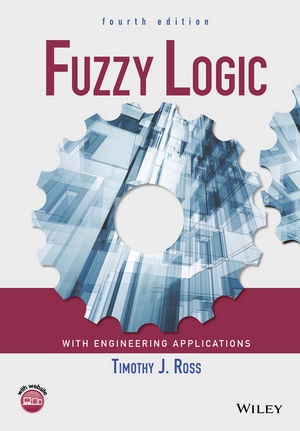Mehr lesen
Fuzzy Logic with Engineering Applications, Fourth Edition
Timothy J. Ross, University of New Mexico, USA
The latest update on this popular textbook
The importance of concepts and methods based on fuzzy logic and fuzzy set theory has been rapidly growing since the early 1990s and all the indications are that this trend will continue in the foreseeable future. Fuzzy Logic with Engineering Applications, Fourth Edition is a new edition of the popular textbook with 15% of new and updated material. Updates have been made to most of the chapters and each chapter now includes new end-of-chapter problems.
Key features:
* New edition of the popular textbook with 15% of new and updated material.
* Includes new examples and end-of-chapter problems.
* Has been made more concise with the removal of out of date material.
* Covers applications of fuzzy logic to engineering and science.
* Accompanied by a website hosting a solutions manual and software.
The book is essential reading for graduates and senior undergraduate students in civil, chemical, mechanical and electrical engineering as wells as researchers and practitioners working with fuzzy logic in industry.
Inhaltsverzeichnis
About the Author xi
Preface to the Fourth Edition xiii
1 Introduction 1
The Case for Imprecision 2
A Historical Perspective 4
The Utility of Fuzzy Systems 7
Limitations of Fuzzy Systems 9
The Illusion: Ignoring Uncertainty and Accuracy 11
Uncertainty and Information 13
Fuzzy Sets and Membership 14
Chance versus Fuzziness 17
Intuition of Uncertainty: Fuzzy versus Probability 19
Sets as Points in Hypercubes 21
Summary 23
References 23
Problems 24
2 Classical Sets and Fuzzy Sets 27
Classical Sets 28
Fuzzy Sets 36
Summary 45
References 46
Problems 46
3 Classical Relations and Fuzzy Relations 51
Cartesian Product 52
Crisp Relations 53
Fuzzy Relations 58
Tolerance and Equivalence Relations 67
Fuzzy Tolerance and Equivalence Relations 70
Value Assignments 72
Other Forms of the Composition Operation 76
Summary 77
References 77
Problems 77
4 Properties of Membership Functions, Fuzzification, and Defuzzification 84
Features of the Membership Function 85
Various Forms 87
Fuzzification 88
Defuzzification to Crisp Sets 90
lambda-Cuts for Fuzzy Relations 92
Defuzzification to Scalars 93
Summary 102
References 103
Problems 104
5 Logic and Fuzzy Systems 107
Part I: Logic 107
Classical Logic 108
Fuzzy Logic 122
Part II: Fuzzy Systems 132
Summary 151
References 153
Problems 154
6 Historical Methods of Developing Membership Functions 163
Membership Value Assignments 164
Intuition 164
Inference 165
Rank Ordering 167
Neural Networks 168
Genetic Algorithms 179
Inductive Reasoning 188
Summary 195
References 196
Problems 197
7 Automated Methods for Fuzzy Systems 201
Definitions 202
Batch Least Squares Algorithm 205
Recursive Least Squares Algorithm 210
Gradient Method 213
Clustering Method 218
Learning from Examples 221
Modified Learning from Examples 224
Summary 233
References 235
Problems 235
8 Fuzzy Systems Simulation 237
Fuzzy Relational Equations 242
Nonlinear Simulation Using Fuzzy Systems 243
Fuzzy Associative Memories (FAMs) 246
Summary 257
References 258
Problems 259
9 Decision Making with Fuzzy Information 265
Fuzzy Synthetic Evaluation 267
Fuzzy Ordering 269
Nontransitive Ranking 272
Preference and Consensus 275
Multiobjective Decision Making 279
Fuzzy Bayesian Decision Method 285
Decision Making under Fuzzy States and Fuzzy Actions 295
Summary 309
References 310
Problems 311
10 Fuzzy Classification and Pattern Recognition 323
Fuzzy Classification 324
Classification by Equivalence Relations 324
Cluster Analysis 332
Cluster Validity 332
c-Means Clustering 333
Hard c-Means (HCM) 333
Fuzzy c-Means (FCM) 343
Classification Metric 351
Hardening the Fuzzy c-Partition 354
Similarity Relations from Clustering 356
Fuzzy Pattern Recognition 357
&
Über den Autor / die Autorin
Timothy J. Ross, University of New Mexico, USA
Dr. Ross is a professor within the Department of Civil Engineering at the University of New Mexico where he teaches courses in structural analysis, structural dynamics and fuzzy logic. He is a registered professional engineer with over 30 years' experience in the fields of computational mechanics, hazard survivability, structural dynamics, structural safety, stochastic processes, risk assessment, and fuzzy systems. He is also the founding Editor-in-Chief of the International Journal, Intelligent and Fuzzy Systems.
Zusammenfassung
Fuzzy Logic with Engineering Applications, Fourth Edition Timothy J.

